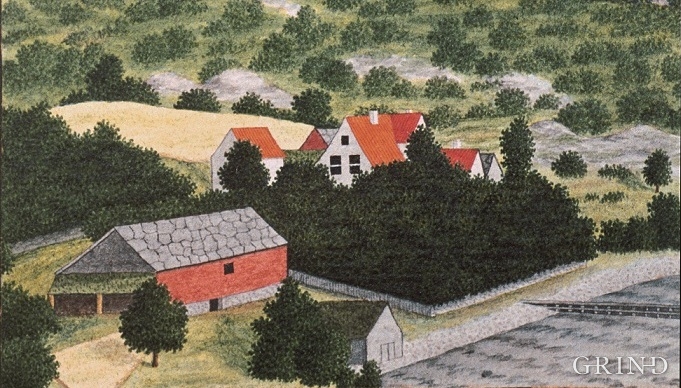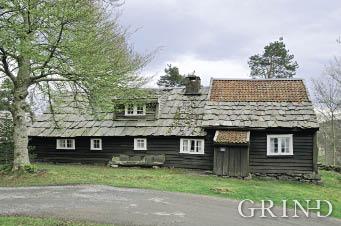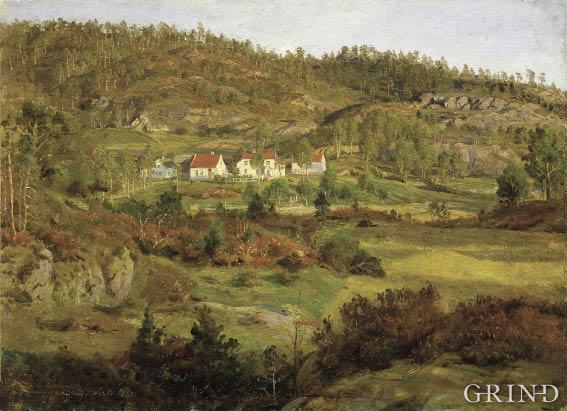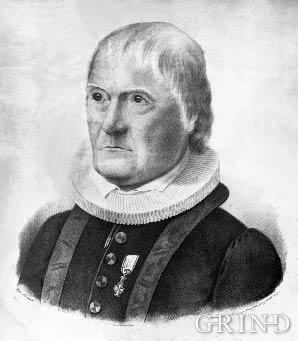Published: 19.05.2009 | Author: Anne-Hilde Nagel
Catharine Kølle, “Hesthammer”, undated. (Helge Sunde, owner: Universitetsmuseet i Bergen (B 2436b, 11,3x8,9)) (utsnitt)
The white painted Rococo building on Hesthamar, the magistrate’s estate just north of Utne in Hardanger, with its steep, pointed gable roof stands out in the landscape. This beautiful and well preserved official estate house from the early 18th century stands there as a witness to a period when civil servants were powerful and stood on the top rungs of the social ladder.
In Hordaland there are many such official estate houses, such as the Captain’s Estate at Fet in Uskedalen, an example of well proportioned classic Bergen style, or the official estate house of the company chief at Undarheim in Husnes, both from the second half of the 18th century. Somewhat smaller, but still bigger than an ordinary farmhouse is the main building on the rectory in Vikøy in Hardanger or the dwelling house from the bailiff’s estate at Sørhuglo which stands today in the Sunnhordland Folk Museum at Stord.
The magistrates, priests, bailiffs and the military officers were the principal representatives of the civil service in the rural areas. They belonged to the culture of the towns, and this showed itself in the social conventions and in the building styles. The main house on an official estate was usually a stylistically pure building with a long façade and large windows, with a public office, a large hall – a room for the gentlemen - for social purposes, bedrooms, public rooms for the whole household and often a servants’ hall for the servants. The distinction between an official estate house and an ordinary farmhouse became quite clear from the size of the household.
While on average 5 or 6 adults and children lived on a farm around 1800, there could be 15 to 25 persons in an official estate house, depending on the rank of the civil servant and the wealth of the district. There were many officials attached to the civil servants They often had the biggest and best estates in the area, and agriculture was an important part of the civil servant’s economy.
A state governed by civil servants
The period of two hundred years from 1660 to 1884 is known as the Civil Servants’ State in Norwegian history. Civil servants were in the Government, they filled the positions in the central administration and they were responsible for local government. The royal appointment was the real mark of the civil servant. He was to be the king’s representative in his own district. This conferred upon him power and authority. But at the same time the civil servants had to have the confidence of local society since part of their salary came directly from the people of the rural areas.
And there were other ways in which the civil servant stood out. They belonged to an exclusive little group. Including their families they accounted for only 1% of the population. They were immigrants or descendants of immigrants. Most of them spoke Danish and had an official uniform. They were bound together in a social community through marriage and friendship. They had a common background as children of servant servants, and more and more of them were educated at the University in Copenhagen. Gradually it also became more usual for the son to go in for the same type of service as his father and so we got church families, officer families and so on. The division between the civil servants and the farmers was probably less in Norway than in many other countries, because the upper levels of the farming society, the big farmers were, in a manner, well off, and because great riches have been relatively rare in this country. Nonetheless the distance between farming society and the community of civil servants can have seemed greater here than in many other places. Socially and administratively civil servants have had a more prominent position in Norwegian society than in most European countries. This had to do with the weak position of the nobility.
In the 17th century new social groups took over the leading positions in society after the nobility. The civil servants the prominent citizens were the economic and social elite in the country. The position and power of the civil servants were strengthened through the development and centralisation of the civil administration in Denmark-Norway with the introduction of the absolute monarchy in 1660. The great civil servants’ estates are a visible expression of this development. Most of these were built in the second half of the 18th century.
Magistrate, bailiff, priest and captain
Before the Executive Committee Laws of 1837 introduced municipal self-government, the official authorities in the rural areas were the same as the State’s local administration.
This was the case both before 1814 when the king ruled as an absolute monarch from Copenhagen, and in the first period of union when the king resided in Stockholm and had to share power with the Norwegian Parliament in Christiania. In popular opinion, the public authorities were the same as the local civil servants, and the most important of these were the magistrate, the bailiff and the priest. Even although they had assistants below them and supervisory official above them, it was this triumvirate who carried out most of the official tasks that the farming society required. Together with military captain in the area, they made sure that people contributed what the state required of them. The magistrate, the bailiff, the priest and the captain assisted each other in a number of matters, but otherwise each of them representing their own branch of the government administration: the judiciary, the local administration, the Church and the military.
The magistrate and the courts
The magistrate was the judge in the rural council. When the position was established in 1591 he was right enough only the sworn secretary for the rural council, whilst the farmers themselves had the powers to make judgements. But gradually the magistrate took over the judicial functions. First of all he was an associate judge with the farmers, but later he became the sole judge, as is laid down in Christian V’s Norwegian Law of 1687. At the same time he continued to be a lawyer and wrote the court protocols. It was also the magistrate who gave rulings on property, functioned as auctioneer and kept the records of pledges and securities. His function was to participate in different commissions, to serve as public notary and he was the first to sign and co-sign petitions to the king from the people.
The bailiff and the district administration
The bailiff had a complex set of official duties. He had duties within the military, within the school and with the poor house, as well as administering trade regulations and the maintenance of roads. In addition after 1814 he took on duties in connection with the election to the Storting (The Norwegian Parliament), and after 1837 elections to the municipal councils. Nonetheless his most important duties were as tax collector and police authority.
Within his district the bailiff had the responsibility for collecting taxes, duties and fines. Normally he did this through the rural council which was also called the tax council. The tax council was held at fixed times, two or three times a year and the farmers had a duty to appear. It often happened that everything did not come in, and then the bailiff had to travel round the district to collect the arrears. In some cases he had to take out mortgages, or use the military. The bailiff was to deliver the taxes collected to the public treasury in the nearest regional administration, of which there were three in Norway at the beginning of the 18th century. The bailiffs in the Hordaland area delivered to the regional administration in Bergen. From there the money went to the Zahl Treasury in Christiania, and in the Danish period, onward to Copenhagen.
The bailiff was also the police chief in the country districts. His job was to take care of law and order in his district. He had powers of arrest, he was prosecutor in official matters and it was he who was responsible that judgements were implemented. The local policemen were the bailiff’s local assistants within the district.
Monastery estates and the barony
Some properties and groups of properties were separated as legal entities on their own and as judicial districts, so-called birk. The property within a birk did not come under the ordinary powers that be, but under the landowner. In this way the administrative, legal and economic power was gathered together under one roof.. In some countries, like Denmark, such arrangements were normal, but in Norway it was the exception. There were never many birks, and most of them were small. In the 17th century we had two birks in the country, Halsnøy Monastery Estate in Sunnhordland and Hardanger, and Lyse Monastery estate in Sunnhordland, Hardanger and Nordhordland. Both of these were collections of properties which the king had taken over after the Reformation. At the end of the 17th century four more birks were established, one of which was the Rosendal Barony.
All birks in the Hordaland areas were collections of properties, that is to saw the birk law did not apply to the whole area, but only to the tenants who belonged to that property.
The master of the birk had the right to appoint birk judges and a birk bailiff. In Norway the duties of a birk judge corresponded mostly to those of the magistrate, and the birk bailiff had the same responsibilities as an ordinary bailiff. For Halsnøy and Lyse Monasteries the appeal from the Birk Council should go to the parliamental court (lay council), whilst the Barony got its own parliamental court law, that is to say that appeals go straight to the High Court. The Barony had a so-called right of appointment, that is the right to appoint priests. Neither the baron nor the other birk chiefs had any authority over military matters; the State authorities themselves wanted to deal with these. Administratively Halsnøy and Lyse Monasteries came under the County Governor, while the Baron of Rosendal was a County Chief in his own right. As for other County Commissioners, the Baron came under the Regional Governor .
The vicar and the church
The role of the priest was greater in a period when the church had more power than it does today. Church attendance and taking of the sacrament were compulsory. The priest also had the right to sit in judgement on people by way of church discipline and the ecclesiastical courts. In addition the priests had more pronounced secular duties than today. From ancient times the Church had been engaged in care of the poor and education. When the state took over these as official responsibilities in the middle of the 18th century it was the priests who were the natural leaders of the new arrangements for a commissioner for the poor and a commissioner for education in each parish. The Church was also imposed with State control and propaganda functions. The priest was to keep a record of the electorate, and conduct censuses for, amongst other things, the purposes of the military. His duty was also to read out announcements from the church or the pulpit. In a royal proclamation from 1734 it is stated that the priest will put emphasis on “maintaining peace amongst the citizenry” and commanding his parishioners to “Avoid all disturbances, disputes, conspiracy, hatred and contempt”
When people talk of the priest they mean the parish priest. It was him they met on feast days and on days of celebration. Many places, the rectory was also a cultural centre for the rural area. Here many of the country folk had their first encounter with written knowledge before the school system was developed. Compared with the magistrate and the bailiff, the priest was closer to the people in his work. And his working district was smaller too. Whilst the country was divided up judicially and administratively into about 300 councils, there were about 900 parishes. There were often several parishes in a church district which was the parish priest’s district. It was only at the level of the dean where the church corresponded with the bailiff and the magistrate. The ecclesiastical administration corresponds to a large extent with the system we still have. The dean was chosen from the parish priests in the church district. Above him was the bishop. Under him the parish priest could have local curates in remote parts of the church district, and domestic curates as personal assistants. The parish clerk in the parish was to help the priest with the divine service, to lead the church choir and to instruct young people. He was not really a civil servant, but was appointed by the bishop and was to get his salary from the common people as was the custom. He was also entitled to a parish clerk’s house within the parish.
The captain and military power
The captain and his lieutenant were the two military officers the people had most dealings with. The captain was the commander of the local militia company. He had a house in keeping with those of the civil servants, and it was he, to a large extent, who represented the power of the State within local society. The military power had long enjoyed the highest priority in public affairs. Towards the end of the 18th century more than three quarters of public expenditures went to the military.
The military powers had more varied duties and came into wider contact with people in local society than they do today. War and protection against external threat was a principal duty then as now. Military forces were also used in the case of internal disturbances. This could often become violent, but on other occasions the presence of soldiers themselves was enough to quieten excited mobs, as in the uprising against extra tax in western Norway in the 1760s, the so-called Strile War. In addition the military were there to assist the authorities in more day-to-day policing duties, for example in collecting tax arrears (military execution), in arresting criminals and transporting prisoners.
The Norwegian Army which was established in 1628 was mainly an army based on compulsory military service. But the compulsion was not personal, but distributed amongst the farms on a parish system. Each parish had to equip and maintain a soldier. They usually started at the bottom of the social ladder, with a peasant boy. When the potential soldiers came up for military service, the captain, the county governor and several civil servants were present. Those who were accepted as soldiers were to serve for nine years. But in peacetime service consisted mostly of turning up at fixed times outside the church, where exercises were held under the direction of the captain.
The civil servants and the common people
The civil servants represented the State or the king within local society. But it did happen that farmers travelled to Copenhagen to complain to the king. Such journeys to complain were forbidden several times, but they were taken up again. Most commonly the travellers were allowed to announce their mission, not least because the regulations gave the central authorities power to check and control the local civil servants. Nonetheless journeys to Copenhagen were rarely seen. At home it was possible for the farmers to make use of the local councils to take action in important matters, for example against new tax claims. The most usual way of approaching the authorities was by way of a letter of complaint or petition from the individual person, the so-called supplication. Supplications could be used for everything from a complaint against a zealous bailiff, to making an application to run a business, to seeking clemency in the matter of a punishment. Supplications were accepted by the system. There were rules for how they should proceed through the administrative system, and no civil servant had the right to refuse or hinder a supplication.
The relationship between the civil servants and the common people was characterised by the fact that the civil servants had the instruments of power with respect to the common people. But to a certain degree they also had the same interests. Local society was not large, and people had to live with each other, and the civil servants were economically dependent on the relationship functioning well enough for them to get their income, and preferably some “gifts” in addition. There are many examples of the civil servants speaking on behalf of local society against the central authorities in the capital city. Otherwise the civil servants had to take a position in matters where different groups in the population were opposed to one another. The civil servants usually supported the farmers, for example on the question whether the peasants should be a reserve of labour for the farms, or whether the peasant should be made independent small farmers. Not only were the farmers more powerful economically than the peasants, they also had important functions in the State. It was they who paid tax, they were obliged to provide transport and it was they who provided soldiers for the Army.
The culture of the civil servants
The duties of the civil servants were to manage and to control. To perform these duties it was necessary to be a scholar and to master the arts of reading and writing. This conferred power in a society where most people until late in the 19th century could not write much more than their name. The civil servants wrote mainly in Danish, and so contributed their bit to the subsequent language conflicts in the country. Many of them read several languages, and received impulses from the major cultural countries in Europe. Most of the poets and scientists we know in Norway in the 17th and 18th centuries were civil servants. In Bergen Bishop Erik Pontoppidan wrote: “The Natural History of Norway” in the middle of the 18th century and the poet and bishop Johan Nordahl Brun, around 1800, wrote Norway’s first national anthem (For Norway, the Giants Birthplace) and the song for Bergen (I took my newly tuned zither). All in all many civil servants in the latter half of the 18th century were characterised by rationalism. They wanted to give knowledge to the people. This was true not least for the priests. They were pioneers within agriculture (the “potato priests”) and they used the pulpits for educational purposes. The events of 1814 (the drafting and adoption of an independent Norwegian Constitution at Eidsvoll) also showed the civil servants were well abreast of trends of thought in Europe. The civil servants mainly dominated the work on the Constitution, and they drew on ideas from the American struggle for independence and the constitutions of the French revolution. Even although many civil servants got a role as popular educators, and although the way they lived could have been an example for others, the culture of the civil servants was nonetheless exclusive. There was a close social bind between civil servants across local societies because of marriage, friendship and knowledge. They identified themselves more with each other and with their foreign counterparts than with the local population. They held parties for each other. They built in the style of the city, and they introduced fashions in clothing inspired by the Empire. They could enjoy baroque music played on expensive instruments like the spinet. And above all they had the resources to do it. The culture of the civil servant emerged as an upper-class culture, cut off from and very unlike the local farming culture.
The rule of the civil servants comes to an end
Freedom from Denmark and the Constitution of 1814 had little impact on local government. The same men sat in the same positions and ruled more or less as before. Nor did the introduction of municipal government from 1837 bring much change to the local public administration. In the first decades after 1837 it was still unclear to many people what the municipal councils were supposed to do. And still the people chose civil servants to represent them in the Storting (the Norwegian Parliament). If we look at the election to the Storting in 1848 of the four representatives from Søndre Bergenshus there was only one farmer, Johannes Olsen Veseth from Haus. The three others were civil servants; priests all three of them. They were Nils Koren of Kinsarvik deanery, Claus Daae of Stord and Laurentius Koren, dean of Sunnhordland and parish priest in Fjeldberg. Amongst the substitutes was yet another parish priest, Julius Hammer of Haus, and a magistrate, Jacob Falch, magistrate in Hardanger and Voss magistracy. It was only when the parliamentary opposition in the Storting defeated the rule of the civil servants in 1884, and parliamentarism was introduced as the system of Government in Norway, that the rule of the civil servants in local administration take a knock. The municipal councils got more power, through, amongst other things, the appointment of local policemen. Several state appointments were abolished, including the position of bailiff in 1894. The transition from a civil servant system of government to a more local independent system of government was, in other words, a process that moved forward in parallel on two levels. The municipality was more powerful, at the same time as the State administration was dismantled. Towards the end of the 19th century the period of rule by the civil servant came gradually to an end.
- Nagel, A.-H. (1985) Styringsapparatet i Norge på 1700-tallet. I: Administrasjon i Norden på 1700-talet. Oslo, Universitetsforlaget, s. 71-144.










